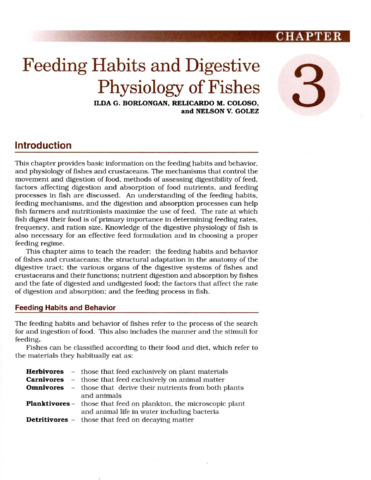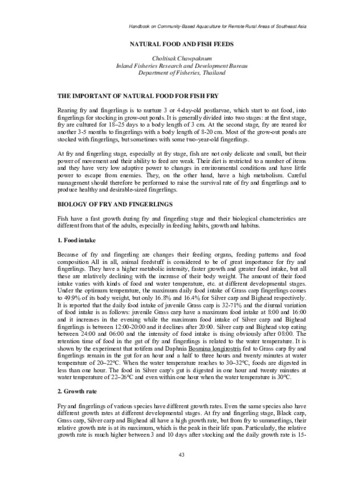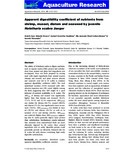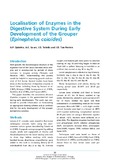Feeding habits and digestive physiology of fishes
Share
ບົດຄັດຫຍໍ້
This chapter provides basic information on the feeding habits and behavior, and physiology of fishes and crustaceans. The mechanisms that control the movement and digestion of food, methods of assessing digestibility of feed, factors affecting digestion and absorption of food nutrients, and feeding processes in fish are discussed. An understanding of the feeding habits, feeding mechanisms, and the digestion and absorption processes can help fish farmers and nutritionists maximize the use of feed. The rate at which fish digest their food is of primary importance in determining feeding rates, frequency, and ration size. Knowledge of the digestive physiology of fish is also necessary for an effective feed formulation and in choosing a proper feeding regime.
This chapter aims to teach the reader: the feeding habits and behavior of fishes and crustaceans; the structural adaptation in the anatomy of the digestive tract; the various organs of the digestive systems of fishes and crustaceans and their functions; nutrient digestion and absorption by fishes and the fate of digested and undigested food; the factors that affect the rate of digestion and absorption; and the feeding process in fish.
Suggested Citation
Borlongan, I. G., Coloso, R. M., & Golez, N. V. (2002). Feeding habits and digestive physiology of fishes. In O. M. Millamena, R. M. Coloso, & F. P. Pascual (Eds.), Nutrition in Tropical Aquaculture: Essentials of fish nutrition, feeds, and feeding of tropical aquatic species (pp. 77–97). Tigbauan, Iloilo, Philippines: Aquaculture Department, Southeast Asian Fisheries Development Center.
Contents
- Introduction
- Feeding habits and behavior
- Anatomy and physiology of the digestive system
- Fishes
- Crustaceans
- Digestion and absorption
- Digestion and absorption of proteins
- Digestion and absorption of carbohydrates
- Digestion and absorption of lipids
- Measurements and analysis used in digestion studies
- Measurements of stomach contents
- Measurement of digestibility
- Factors affecting digestion and absorption
- Feeding process in fish
- Appetite and satiation
- Arousal and search
- Location and identification
- Capture
- Taste testing
- Swallowing or rejection
- Summary
- Guide questions
- Suggested readings
ວິຊາ
feeding  ; feeding habits
; feeding habits  ; anatomy
; anatomy  ; physiology
; physiology  ; fish physiology
; fish physiology  ; head
; head  ; mouth
; mouth  ; oesophagus
; oesophagus  ; stomach
; stomach  ; intestines
; intestines  ; liver
; liver  ; pancreas
; pancreas  ; digestibility
; digestibility  ; biotic factors
; biotic factors  ; food availability
; food availability  ; competitive behaviour
; competitive behaviour  ; abiotic factors
; abiotic factors  ; digestive system
; digestive system  ; epithelium
; epithelium  ; hepatopancreas
; hepatopancreas  ; digestion
; digestion  ; stomach content
; stomach content  ; pepsin
; pepsin  ; trypsin
; trypsin  ; chymotrypsin
; chymotrypsin  ; peptidases
; peptidases  ; in vivo digestibility
; in vivo digestibility  ; in vitro digestibility
; in vitro digestibility  ; appetite
; appetite 
 ; feeding habits
; feeding habits  ; anatomy
; anatomy  ; physiology
; physiology  ; fish physiology
; fish physiology  ; head
; head  ; mouth
; mouth  ; oesophagus
; oesophagus  ; stomach
; stomach  ; intestines
; intestines  ; liver
; liver  ; pancreas
; pancreas  ; digestibility
; digestibility  ; biotic factors
; biotic factors  ; food availability
; food availability  ; competitive behaviour
; competitive behaviour  ; abiotic factors
; abiotic factors  ; digestive system
; digestive system  ; epithelium
; epithelium  ; hepatopancreas
; hepatopancreas  ; digestion
; digestion  ; stomach content
; stomach content  ; pepsin
; pepsin  ; trypsin
; trypsin  ; chymotrypsin
; chymotrypsin  ; peptidases
; peptidases  ; in vivo digestibility
; in vivo digestibility  ; in vitro digestibility
; in vitro digestibility  ; appetite
; appetite 
Related items
Showing items related by title, author, creator and subject.
-
Natural food and fish feeds
Chawpaknum, Choltisak (Secretariat, Southeast Asian Fisheries Development Center, 2008)Rearing fry and fingerlings is to nurture 3 or 4-day-old postlarvae, which start to eat food, into fingerlings for stocking in grow-out ponds. It is generally divided into two stages: at the first stage, fry are cultured ... -
Apparent digestibility coefficient of nutrients from shrimp, mussel, diatom and seaweed by juvenile Holothuria scabra Jaeger
Orozco, Zenith Gaye Almeda; Sumbing, Joemel Gentelizo; Lebata-Ramos, Ma. Junemie Hazel; Watanabe, Satoshi (Wiley, 2014)The ability of Holothuria scabra to digest nutrients, such as organic matter (OM), protein and carbohydrate from animal and plant feed ingredients was investigated. Four test feeds prepared by mixing sand with single ... -
Localisation of enzymes in the digestive system during early development of the grouper (Epinephelus coioides)
Quinitio, Gerald F.; Sa-an, Analyn C.; Toledo, Joebert D.; Tan-Fermin, Josefa D. (Australian Centre for International Agricultural Research, 2004)This study was undertaken to investigate the occurrence of some digestive enzymes in the gastrointestinal tract during early development in the grouper. This work was conducted to provide information on formulating an ...




